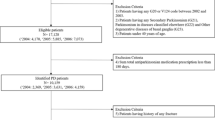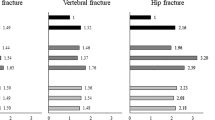Abstract
Summary
Among community-dwelling older men, compared to those without Parkinson’s disease (PD), over approximately 5 years, those with baseline PD had a significantly greater rate of annualized total hip bone loss (−1.1% vs. 0.4%), proportion of incident non-spine fractures (14.9% vs. 7.2%) and mortality (34.8% vs. 9.5%).
Introduction
The objective of this study was to examine the association of Parkinson’s disease (PD) with bone loss and fractures in older men.
Methods
This prospective cohort study analyzed data from 5,937 community dwelling men aged ≥65 years at six clinical centers of the Osteoporotic Fractures in Men (MrOS) Study. At baseline and visit two (mean interval 4.6 +/−0.4 SD years), community-diagnosed PD was ascertained by self-report and hip bone mineral density (BMD) was measured using dual energy x-ray absorptiometry (DXA). Incident fractures were self-reported. Fractures and deaths were centrally adjudicated.
Results
At baseline, 46 (0.8%) men had PD. Age-adjusted mean annualized total hip bone loss was greater in men with vs. those without PD (−1.08% vs. −0.36%, p < 0.001). 15.2% of men with PD and 7.2% of men without PD experienced an incident non-spine fracture (age-adjusted HR 2.4, 95%CI 1.1–5.0). 34.8% of men with PD and 9.5% of men without PD died during follow-up (age-adjusted HR 3.5, 95%CI 2.2–5.5). Associations of PD with bone loss, fractures and mortality were modestly altered by additional individual adjustment for possible confounders.
Conclusions
In community-dwelling older men, PD was associated with increased bone loss, fractures and mortality. In addition to implementing fall prevention measures, clinicians should consider osteoporosis screening in older men with PD.

Similar content being viewed by others
References
Sato Y, Kikuyama M, Oizumi K (1997) High prevalence of vitamin D deficiency and reduced bone mass in Parkinson’s disease. Neurology 49:1273–1278
Taggart H, Crawford V (1995) Reduced bone density of the hip in elderly patients with Parkinson’s disease. Age Ageing 24:326–328
Kao CH, Chen CC, Wang SJ, Chia LG, Yeh SH (1994) Bone mineral density in patients with Parkinson’s disease measured by dual photon absorptiometry. Nucl Med Commun 15:173–177
Fink HA, Kuskowski MA, Orwoll ES, Cauley JA, Ensrud KE (2005) Association between Parkinson’s disease and low bone density and falls in older men: the osteoporotic fractures in men study. J Am Geriatr Soc 53:1559–1564
Sato Y, Manabe S, Kuno H, Oizumi K (1999) Amelioration of osteopenia and hypovitaminosis D by 1alpha- hydroxyvitamin D3 in elderly patients with Parkinson’s disease. J Neurol Neurosurg Psychiatry 66:64–68
Sato Y, Honda Y, Kaji M, Asoh T, Hosokawa K, Kondo I, Satoh K (2002) Amelioration of osteoporosis by menatetrenone in elderly female Parkinson’s disease patients with vitamin D deficiency. Bone 31:114–118
Johnell O, Melton LJ III, Atkinson EJ, O’Fallon WM, Kurland LT (1992) Fracture risk in patients with parkinsonism: a population-based study in Olmsted County, Minnesota. Age Ageing 21:32–38
Grisso JA, Kelsey JL, Strom BL, Chiu GY, Maislin G, O’Brien LA, Hoffman S, Kaplan F (1991) Risk factors for falls as a cause of hip fracture in women. The Northeast Hip Fracture Study Group. N Engl J Med 324:1326–1331
Genever RW, Downes TW, Medcalf P (2005) Fracture rates in Parkinson’s disease compared with age- and gender-matched controls: a retrospective cohort study. Age Ageing 34:21–24
Taylor BC, Schreiner PJ, Stone KL, Fink HA, Cummings SR, Nevitt MC, Bowman PJ, Ensrud KE (2004) Long-term prediction of incident hip fracture risk in elderly white women: study of osteoporotic fractures. J Am Geriatr Soc 52:1479–1486
Blank JB, Cawthon PM, Carrion-Petersen ML, Harper L, Johnson JP, Mitson E, Delay RR (2005) Overview of recruitment for the osteoporotic fractures in men study (MrOS). Contemp Clin Trials 26:557–568
Orwoll E, Blank JB, Barrett-Connor E, Cauley J, Cummings S, Ensrud K, Lewis C, Cawthon PM, Marcus R, Marshall LM, McGowan J, Phipps K, Sherman S, Stefanick ML, Stone K (2005) Design and baseline characteristics of the osteoporotic fractures in men (MrOS) study-a large observational study of the determinants of fracture in older men. Contemp Clin Trials 26:569–585
Washburn RA, Smith KW, Jette AM, Janney CA (1993) The Physical Activity Scale for the Elderly (PASE): development and evaluation. J Clin Epidemiol 46:153–162
Drugs for Parkinson’s disease (2007) Treat Guidel Med Lett 5:89–94
Ware J Jr, Kosinski M, Keller SD (1996) A 12-Item Short-Form Health Survey: construction of scales and preliminary tests of reliability and validity. Med Care 34:220–233
Hamilton A, Balnave R, Adams R (1994) Grip strength testing reliability. J Hand Ther 7:163–170
Nevitt MC, Cummings SR, Kidd S, Black D (1989) Risk factors for recurrent nonsyncopal falls. A prospective study. JAMA 261:2663–2668
Bassey EJ, Short AH (1990) A new method for measuring power output in a single leg extension: feasibility, reliability and validity. Eur J Appl Physiol Occup Physiol 60:385–390
Eng ML, Lyons KE, Pahwa R (2006) Prevalence of bone mineral density screening in Parkinson’s disease clinic outpatients. Mov Disord 21:2265–2266
Sato Y, Honda Y, Iwamoto J (2007) Risedronate and ergocalciferol prevent hip fracture in elderly men with Parkinson disease. Neurology 68:911–915
Sato Y, Iwamoto J, Kanoko T, Satoh K (2006) Alendronate and vitamin D2 for prevention of hip fracture in Parkinson’s disease: a randomized controlled trial. Mov Disord 21:924–929
Bakhireva LN, Barrett-Connor E, Kritz-Silverstein D, Morton DJ (2004) Modifiable predictors of bone loss in older men: a prospective study. Am J Prev Med 26:436–442
Szulc P, Delmas PD (2007) Bone loss in elderly men: increased endosteal bone loss and stable periosteal apposition. The prospective MINOS study. Osteoporos Int 18:495–503
Potential financial conflicts of interest
Dr. Schousboe receives research grant support from Hologic, Inc. Dr. Ensrud receives research grant support from Bionovo. Dr. Orwoll receives research, consulting or speaking support from Aventis, Pfizer, Eli Lilly & Co., Novartis, Merck & Co., Procter & Gamble, GlaxoSmithKline, Zelos Therapeutics Inc., Imaging Therapeutics Ind., and Solvay Pharmaceuticals. All other authors have no conflicts of interest.
Author contributions
Conception and design: H.A. Fink, M.A. Kuskowski
Acquisition of participants and/or data: E.S. Orwoll, K.E. Ensrud
Analysis and interpretation of the data: H.A. Fink, M.A. Kuskowski, B.C. Taylor, J.T. Schousboe, K.E. Ensrud
Drafting of the article: H.A. Fink
Critical revision of the article for important intellectual content: H.A. Fink, M.A. Kuskowski, B.C. Taylor, J.T. Schousboe, E.S. Orwoll, K.E. Ensrud
Final approval of the article: H.A. Fink, M.A. Kuskowski, B.C. Taylor, J.T. Schousboe, E.S. Orwoll, K.E. Ensrud
Sponsor’s role
The funding agencies played no role in the design, analysis and preparation of this manuscript.
Author information
Authors and Affiliations
Consortia
Corresponding author
Additional information
Funding sources
The Osteoporotic Fractures in Men (MrOS) Study is supported by National Institutes of Health funding. The following institutes provide support: the National Institute of Arthritis and Musculoskeletal and Skin Diseases (NIAMS), the National Institute on Aging (NIA), the National Center for Research Resources (NCRR) and NIH Roadmap for Medical Research under the following grant numbers: U01 AR45580, U01 AR45614, U01 AR45632, U01 AR45647, U01 AR45654, U01 AR45583, U01 AG18197, U01-AG027810, and UL1 RR024140.
Rights and permissions
About this article
Cite this article
Fink, H.A., Kuskowski, M.A., Taylor, B.C. et al. Association of Parkinson’s disease with accelerated bone loss, fractures and mortality in older men: the Osteoporotic Fractures in Men (MrOS) study. Osteoporos Int 19, 1277–1282 (2008). https://doi.org/10.1007/s00198-008-0584-4
Received:
Accepted:
Published:
Issue Date:
DOI: https://doi.org/10.1007/s00198-008-0584-4




